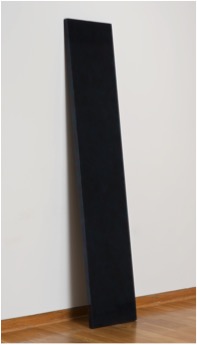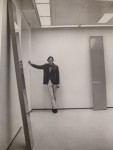
John McCracken
American, 1934-2011
Untitled, 1985
polyester resin, fiberglass, and plywood
102 3/4 x 19 3/4 x 2 in.
SBMA, Gift of Dr.and Mrs. Albert E. Amorteguy
1998.36

Working with what he called “planks,” John McCracken created Minimalist sculptures that bridge the material world with the metaphysical. By leaning the planks against the wall, McCracken’s intention was to connect the spheres of two-dimensional painting and three-dimensional sculpture. His method involved a laborious process of painting, sanding, and polishing the polyester resin on each plywood board to achieve a flawless patina that looks machine-made, bringing to mind the 1960s West Coast “Finish Fetish Art” aesthetic. The most dramatic effect of his glossy surfaces is the way they become as reflective as mirrors and oftentimes seem to disappear altogether, such as in his 1985 work Akitanai. “My tendency,” McCracken once said, “is to reduce or develop everything to 'single things'—things which refer to nothing outside [themselves] but which at the same time possibly refer, or relate, to everything.” - Artsy

McCracken with his 1989 sculpture Hopi. Photo: © The Estate of John McCracken, courtesy of David Zwirner, New York/London
COMMENTS
McCracken began producing his vibrant monochrome “planks” in 1966. While the polished resin surface captures the aesthetic of surfing and car culture unique to Southern California in the 1960s, some titles are drawn from advertising slogans in fashion magazines. The work’s interaction with both the floor and wall is meant to call attention to the space occupied in the gallery by both viewer and object. “I see the plank as existing between two worlds,” McCracken has said, “the floor representing the physical world of standing objects, trees, cars, buildings, human bodies, and everything, and the wall representing the world of the imagination, illusionistic painting space, human mental space, and all that.”
